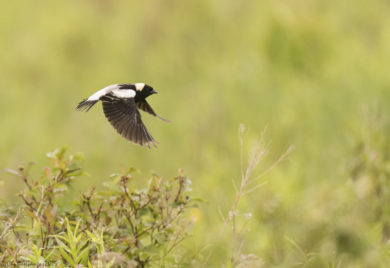
Delaying mowing on hayfields gives Bobolinks time to raise young but can also pose challenges (Photo by Charles Gangas)
See Bobolinks up close and learn about managing grasslands to benefit these declining birds
8-10:30 am on Saturday June 3 at 70 Cossingham Rd, Norwich. RSVP:
Spring ushers in a flurry of activity, from the decluttering of closets to the priming of grills. Meanwhile a bustling hum also emanates from fields and forests as many species of wildlife begin their rituals of courtship and mating. There is more going on than meets the eye of the casual observer. The open fields that give us hay for forage and offer up our serene pastoral views have an entire world of life beneath their canopy of grass. The fate of many of the fields’ busy inhabitants will soon hinge upon landowners’ decisions.
Bobolinks, eastern meadowlarks and Savannah sparrows depend entirely on grasslands, building their nests on the ground, hidden under a protective canopy of grass. In New England’s forest-dominated landscape, farmers have been responsible for supplying the grassland habitat that is used by these declining species. The fate of the birds has been intertwined with the productivity of our local farms.
Landowners with flexibility or who qualify for incentives can provide critical nesting habitat for grassland birds by making adjustments to their mowing schedules. Avoiding mowing Late May to late July allows birds to reproduce and survive. Delaying mowing until August 1 or at least late July allows most fledglings time to develop flight skills needed to avoid machinery. Alternatively, farm operations with less flexibility can make a first cut before June 1 and a second cut after August 5. There are even private and federal programs available that offer financial support for qualifying landowners.
Grassland birds need suitable breeding habitat wherever the opportunity exists. The Vermont Center for Ecostudies has documented severe declines in New England populations. For example, eastern meadowlarks have disappeared from 75% of fields they previously occupied in only the last 15 years. Long-term, declining trends extend across the species’ breeding ranges. Providing suitable breeding habitat on our open lands leaves a legacy of thriving grasslands for future generations.
The Vermont Center for Ecostudies will be banding Bobolinks and joining with the Upper Valley Land Trust to offer management tips at a free workshop for anyone owning or working with grasslands. Experts will share tips, tools, and incentives to strike a balance: production and stewardship. Get to know the birds and their ecology, learn ways to couple bird-friendly mowing regimes with management to maintain field quality, and explore support opportunities. To RSVP and for more information, contact Cathryn Abbott at .
